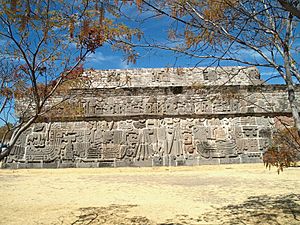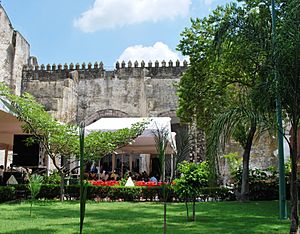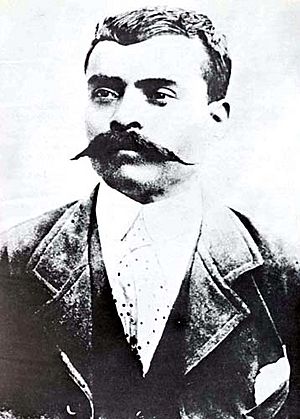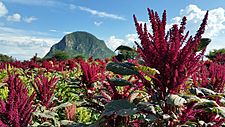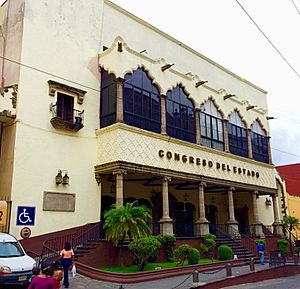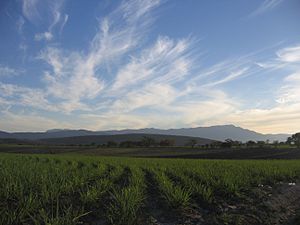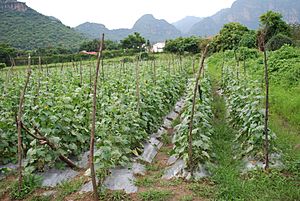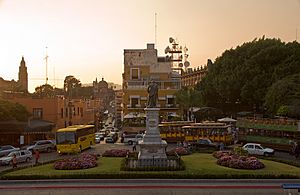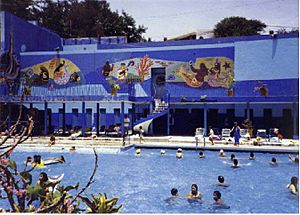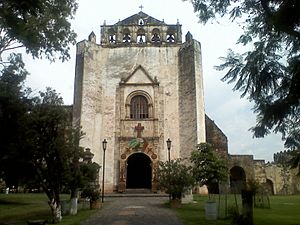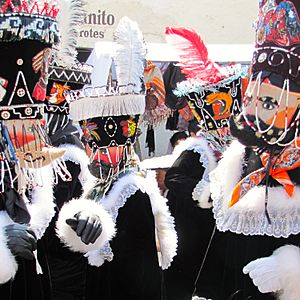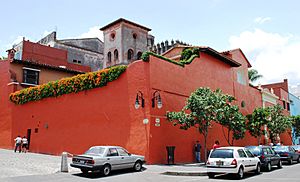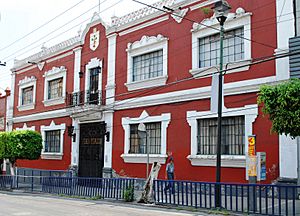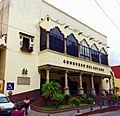Morelos facts for kids
Quick facts for kids
Morelos
|
||
|---|---|---|
| Free and Sovereign State of Morelos Estado Libre y Soberano de Morelos (Spanish) |
||
|
||
| Motto(s):
Tierra y Libertad
('Land and Liberty')
(Coat of arms: La tierra volverá a quienes la trabajan con sus manos [The land will be returned to those who work it with their hands]) |
||
| Anthem: Marcha Morelense | ||

State of Morelos within Mexico
|
||
| Country | Mexico | |
| Capital | Cuernavaca | |
| Largest City | Cuernavaca | |
| Municipalities | 36 | |
| Admission | April 17, 1869 | |
| Order | 27th | |
| Area | ||
| • Total | 4,893 km2 (1,889 sq mi) | |
| • Water | 11.8 km2 (4.6 sq mi) | |
| Ranked 30th | ||
| Elevation | 1,418 m (4,652 ft) | |
| Highest elevation | 5,419 m (17,779 ft) | |
| Lowest elevation | 800 m (2,600 ft) | |
| Population
(2020)
|
||
| • Total | 1,971,520 | |
| • Rank | 23rd | |
| • Density | 402.93/km2 (1,043.58/sq mi) | |
| • Density rank | 2nd | |
| Demonym(s) | Morelense | |
| Time zone | UTC−6 (CST) | |
| • Summer (DST) | UTC−5 (CDT) | |
| Postal code |
62
|
|
| Area code |
Area codes
|
|
| ISO 3166 code | MX-MOR | |
| HDI | ||
| GDP | US$ 7,557.55 mil | |
| a. The state's GDP was 96,736,678 thousand of pesos in 2008, amount corresponding to 7,557,552.968 thousand of dollars, being a dollar worth 12.80 pesos (value of June 3, 2010). | ||
Morelos is one of the 32 states that make up Mexico. Its official name is the Free and Sovereign State of Morelos. It is divided into 36 smaller areas called municipalities, and its capital city is Cuernavaca.
Morelos is a state in south-central Mexico that doesn't touch the ocean. It shares borders with Mexico City to the north, México state to the northeast and northwest, Puebla to the east, and Guerrero to the southwest.
It's the second smallest state in Mexico, only a bit bigger than Tlaxcala. Morelos used to be part of the much larger State of Mexico. But in 1869, Benito Juárez, a famous Mexican president, decided to make it its own state. He named it after José María Morelos, a hero who fought for Mexico's independence. Morelos bravely defended the city of Cuautla against royalist forces during the Mexican War of Independence.
Most of Morelos has a warm climate all year round. This is great for growing crops like sugar cane. Because of its nice weather, people from the Valley of Mexico have been visiting Morelos since Aztec times.
The state is also famous for the Chinelos. These are special costumed dancers who perform at festivals, especially during Carnival. You can see them in many towns across the state. Morelos is also home to the Monasteries on the slopes of Popocatépetl, which are recognized as a World Heritage Site.
Contents
Morelos: A Look at Its Past
Ancient Times: Before the Spanish Arrived
Historians say that the area now known as Morelos is special because of its geography. It's like a basin where lots of water flows. This made it a great place for people to live and grow food.
The first signs of people living in Morelos date back to about 6000 BCE. These early people were nomadic hunters and gatherers. They moved around to find food in areas like Yautepec.
One important early culture was the Olmec, which was powerful from 200 BCE to about 500 CE. You can still see signs of them in places like Chalcatzingo.
Later, different groups from the Valley of Mexico moved into the area. The Toltecs founded Mazatepec in 603 CE. Another group of Toltecs built the city-state of Xochicalco, known as the "City of Flowers." Their influence can be seen in the temple of Quetzalcoatl.
Around the 12th century, the Tlahuicas arrived and settled near Cuernavaca by 1250. They became the main group in Morelos. They lived in about fifty small city-states, each with its own ruler. The Tlahuicas were very good at farming, especially growing cotton. They also had advanced knowledge of astronomy.
The Aztecs started to arrive around 1398. They slowly took control of the area, including Cuernavaca and Oaxtepec. The Aztecs allowed the local rulers to stay, as long as they paid tribute, mostly in cotton. The Aztec emperor Moctezuma I even had a botanical garden in Oaxtepec. The Aztecs also built forts and pyramids, like the one at El Tepozteco in Tepoztlán.
Spanish Conquest and Colonial Rule
In 1519, the Spanish, led by Hernán Cortés, arrived in central Mexico. After some battles, Cortés sent his forces to Morelos. In 1521, they conquered Cuernavaca. Cortés then built his palace there five years later.
Soon after, in 1523, the first church was built in Tlatenango. Over the next 50 years, many churches and religious buildings were constructed in the state.
In 1529, Cortés was given control over a large area in Morelos, with Cuernavaca as his main base. This land stayed with his family until 1809.
From Independence to the Late 1800s
The people of Morelos, especially the local and mixed-race populations, were ready to fight for independence. The first rebellions started in 1811. After Miguel Hidalgo, another independence leader, was executed, José María Morelos took charge.
In 1812, Morelos and his men held the city of Cuautla against a long siege by royalist forces. They held out for 58 days! This was a very important victory for the independence movement. Morelos was later captured and executed in 1815, but the state was named after him to honor his bravery.
After Mexico gained independence, the sugar industry in Morelos made the region very wealthy. Cuernavaca became an important trading center. However, life on the sugar plantations was very hard for the workers, who faced poverty and debt.
Morelos became an official state on April 17, 1869. Its first governor was Francisco Leyva Arciniegas. Over time, roads and telegraph lines were built, connecting the state more to Mexico City.
During the rule of President Porfirio Díaz (1877–1911), the large sugar plantations grew even bigger. They took land from the peasants, causing many towns to disappear. This unfair situation set the stage for the next big conflict.
The Mexican Revolution and the 20th Century
The unfair land situation made Morelos a key place for the Mexican Revolution. This is where Emiliano Zapata, one of Mexico's most famous revolutionaries, was born. He was from a town called Anenecuilco.
Zapata's forces won an important battle in Cuautla in 1911. This led to President Porfirio Díaz stepping down. However, Zapata felt that the new government didn't do enough for land reform. He and his followers then called for major changes in the Plan of Ayala. The state's motto, Tierra y Libertad (Land and Liberty), became a famous cry during this time.
The fighting continued, and Zapata's forces fought against different government armies. In May 1914, Zapata took control of the southern part of Morelos. He even marched on Mexico City.
Sadly, on April 17, 1919, Zapata was betrayed and killed in Chinameca. His body is now in Cuautla, at the base of a statue honoring him. After Zapata's death, his ideas for land reform were finally put into law in Morelos.
In the years after the Revolution, Morelos focused on development. New highways were built, connecting Cuernavaca to Mexico City. In 1961, the Datsun car company started making cars in Jiutepec. The first industrial park, Civac, opened in 1966, bringing more factories to the state.
Morelos was hit by two strong earthquakes in September 2017. The second one, on September 19, caused a lot of damage, especially in Jojutla. Many people died, and thousands of homes, hospitals, and schools were damaged. People from all over Mexico and other countries helped the state recover.
In 2019, three new municipalities were created in Morelos: Xoxocotla, Hueyapan, and Coatetelco. These are Indigenous communities that now have more control over their own affairs.
Geography, Climate, and Nature in Morelos
Morelos is located in the center of Mexico. It covers an area of about 4,893 square kilometers, which is a very small part of Mexico's total land. It's the second smallest state, just after Tlaxcala.
The state's capital is Cuernavaca. This city was originally called Cuauhnahuac by the Tlahuicas. The Spanish changed its name. Cuernavaca is only 90 kilometers south of Mexico City. Because of its pleasant weather, it's often called "The City of Eternal Spring."
Morelos has a varied landscape. About 42% of the state is mountainous, 16% has hills, and 42% is flat land. The highest points are near the border with Mexico City, and the lowest are in the Huaxtla region. The state sits between two major mountain ranges: the Trans-Mexican Volcanic Belt in the north and east, and the Sierra Madre del Sur in the south and west. The tall peaks of the Sierra Ajusco in the north separate Morelos from the Valley of Mexico.
Most of the state's rivers and streams flow into the Amacuzac River, which is a large branch of the Balsas River.
The climate and plants change a lot depending on the elevation. You can find alpine meadows in the high mountains near Popocatépetl and lowland rainforests in the south. About 70% of the state has a warm and humid climate, especially in popular areas like Cuernavaca and Tepoztlán. The average temperature is around 25°C (77°F) all year, with a rainy season from May to September.
Morelos has one important national park called Lagunas de Zempoala National Park. It's one of Mexico's largest national parks. It used to have five mountain-fed lakes and lots of wildlife. However, the park is facing challenges from illegal logging and water being used for cities like Cuernavaca.
People and Culture of Morelos
Population and Communities
Morelos is the second smallest state in Mexico. It ranks 25th out of 32 states in population. However, it is the third most crowded state, after Mexico City and the State of Mexico. Most people (86%) live in cities, with only 14% in rural areas.
Almost 60% of the state's population lives in just seven municipalities: Cuernavaca, Jiutepec, Temixco, Cuautla, Yautepec, Jojutla, and Ayala. The area around Cuernavaca is the most populated.
The population of Morelos has been growing faster than the national average since the mid-1990s. This growth has put a strain on resources like water and schools.
Most people in Morelos are Catholic. There are also smaller groups of evangelical Protestants and Jewish people.
About 8% of the state's population is Indigenous. However, only 2% speak an Indigenous language. Most Indigenous people in Morelos are Nahuas. Many old customs and traditions, like dances, music, and farming practices, are still important to people's identity, often mixed with Catholic beliefs.
In 2020, about 37,569 people in Morelos spoke an Indigenous language. The municipalities with the most speakers include Cuautla, Cuernavaca, and Tetela del Volcán. In 2019, Coatetelco, Hueyapan, and Xoxocotla became special autonomous Indigenous communities.
Government and Politics
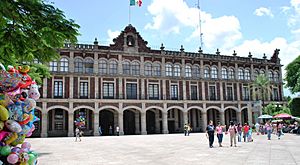
The state of Morelos is led by an elected governor. The governor has a team of leaders who manage different areas like safety, social development, and the economy.
The state also has a Congress, which makes and changes laws. It has 20 "deputies" who represent different districts, and 8 others chosen by proportion.
Morelos has had many governors throughout its history. Francisco Leyva Arciniegas was the first governor after the state was formed in 1869. In recent years, voters have chosen different political parties to lead the state. The current governor, Cuauhtémoc Blanco, was a famous soccer player before he entered politics. He won the election in 2018.
Morelos is divided into 36 municipios (municipalities). These are like local government areas. Some of the biggest communities include Cuernavaca, Jiutepec, and Cuautla.
Economy and Fun Things to Do in Morelos
Economy and Jobs
The economy of Morelos relies on farming, tourism, and city growth. Over time, it has shifted from mostly farming to more industry and trade. However, many smaller towns still depend a lot on agriculture.
Even though Morelos is a small state, its economy is strong enough to attract workers from other parts of Mexico, especially farm workers. However, many people in the state work long hours for low wages.
The state's economy is divided into seven regions. The areas around Cuernavaca are the strongest economically. The less urbanized areas tend to be poorer.
Farming is still an important part of Morelos's economy. About 20% of the working population is involved in farming, ranching, or forestry. Sugar cane has been a key crop since colonial times and is still important today. Rice is another important crop, though its production has decreased.
Morelos is also a major producer of fresh flowers and ornamental plants. It's known for growing roses. The state even claims to be the original home of the poinsettia flower, called noche buena in Spanish.
Other fruits and vegetables grown in Morelos include bananas, melons, cucumbers, and tomatoes. Many crops are grown for families to eat themselves, especially in Indigenous areas.
Industry, mining, and construction make up about 29% of the state's economy. Factories in Morelos produce things like cars, textiles, medicines, and metal products. Most of these goods are sent to other countries like the United States, Canada, and Japan.
There are two main industrial parks in Morelos: Ciudad Industrial del Valle de Cuernavaca (CIVAC) and Parque Industrial de Cuautla (PINC). CIVAC is the most important for the state's economy.
Trade, transportation, services, and tourism make up the largest part of the state's economy, employing over half of the working population. The growth of tourism is a big reason for this.
Tourism and Recreation
Morelos is a popular place for tourists because it's close to Mexico City and has a warm climate. Many people from Mexico City buy second homes here. Visitors also enjoy the state's water parks and spas.
The state's tourism office promotes cities like Cuernavaca and Cuautla. They also highlight the "Magic Towns" of Tepoztlán and Tlayacapan, the ancient site of Xochicalco, and Lake Tequesquitengo.
- Cuernavaca: This city is full of history and culture. You can visit the Palacio de Cortés, which has a famous mural by Diego Rivera. There's also the Cuernavaca Cathedral and the beautiful Borda Garden. Cuernavaca is also known for its Spanish language schools, which attract students from other countries.
- Tepoztlán: This "Magic Town" is known for its craft market and its special "energy." You can hike up to the pyramid of El Tepozteco for amazing views. Tepoztlán's Carnaval is the biggest and most famous in the state, with the lively Chinelos dancers.
- Tlayacapan: This rural town has old mansions and stone-paved streets. It's home to the San Juan Bautista Monastery and many old chapels. Tlayacapan is also known for its unique black pottery.
- Cuautla: This city was important during the Mexican War of Independence. You can visit the Morelos House, where José María Morelos lived during the 1812 siege. Nearby, there are spas and water parks like Agua Hedionda, famous for its sulfur waters.
- Lake Tequesquitengo: This lake is great for water sports like water-skiing, scuba diving, and fishing. Near the lake, you can find the former Vista Hermosa hacienda, which is now a hotel. Jardines de Mexico, the world's largest floral park, is also close by.
Exploring History and Archeology
If you love history, start at the Cuauhnáhuac Regional Museum in the Palacio de Cortés. It shows the history of Morelos from ancient times to the Mexican Revolution. It also has the famous Diego Rivera mural.
Morelos has several amazing ancient sites:
- Chalcatzingo: An Olmec settlement from 750 to 500 BCE, with ancient carvings.
- Xochicalco: The largest and most important ancient site in the state. It was a fortified trading center, possibly built by people from Teotihuacán. It has a Temple of Quetzalcoatl and an observatory. It's a World Heritage Site.
- Teopanzolco: Located in Cuernavaca, this was a ceremonial center built by the Tlahuicas. It has twin temples.
You can also visit the Ruta de los Conventos (Route of the Monasteries). This route takes you to old fortress-like churches and monasteries built in the 16th century around the Popocatépetl volcano. These are also a World Heritage Site.
The Ruta de Zapata (Zapata Route) lets you explore places where General Emiliano Zapata fought during the Mexican Revolution. You can visit his burial site in Cuautla and his headquarters in Tlaltizapan.
Outdoor Adventures
Morelos's warm climate makes it perfect for outdoor sports all year.
- Water Parks: There are many water parks, including natural ones with hot springs. Six Flags Hurricane Harbor in Oaxtepec is a big one. Las Estacas in Tlaltizapan is built around a clear river, great for floating or scuba diving. El Rollo is one of the largest water parks in Latin America.
- Water Sports: You can go water-skiing at Lake Tequesquitengo. Scuba diving and snorkeling are popular at Las Estacas and Lake Tequesquitengo. For thrill-seekers, white-water rafting is available on the Amacuzac River.
- Hiking and Camping: Hiking is popular in the mountainous areas like Huitzilac and Tepoztlán. Many water parks allow camping. The YMCA and the Scouts of Mexico have large campgrounds in Tepoztlán.
- Zoos and Wildlife: Zoológico Zoofari in Amacuzac is a safari park where you can see zebras, lions, giraffes, and more. You can even take pictures with animal cubs! The Parque Ecológico Chapultepec in Cuernavaca has a small petting zoo and a butterfly sanctuary.
Culture and Arts in Morelos
Food and Local Dishes
Morelos has delicious food! In Cuernavaca, you can try chicken in green mole, tortilla soup, and trout. A very typical dish in Cuernavaca is the taco acorazado, which has two large tortillas, rice, and beef or chicken. Tacos al pastor (marinated pork cooked on a vertical rotisserie) are also very popular.
If you travel from Mexico City to Cuernavaca, you might stop in Tres Marias. This town is famous for its quesadillas, mushroom soup, and longaniza (a type of sausage).
Yecapixtla is known for its cecina, which is salted beef often served with fresh cream. Jantetelco is famous for its crystalized fruit, and Alpuyeca is known for its ice cream.
The Aztec god of pulque (a drink made from fermented maguey) was said to be born in Tepoztlán. Today, most pulque in Morelos comes from Huitzilac. You can also find Mezcal and local craft beers.
Music, Dance, and Festivals
Much of Morelos's traditional music is corridos. These are sung stories, often about heroes and events. The Banda Tlayacapan, formed in 1870, is the state's oldest band and helps keep traditional melodies alive.
The Dance of the Chinelos is a special tradition in Morelos. It's popular during many events, especially Carnaval. The Chinelos wear colorful costumes and masks and jump around in the streets. This dance started in Tlayacapan and spread to other parts of Morelos. Today, the Chinelo is a symbol of the state's identity.
Many communities in Morelos celebrate Carnival in the days before Ash Wednesday. These celebrations are unique because of the Chinelos dancers and the lively music played by wind instrument bands.
Art and Literature
After the Mexican Revolution, many muralists came to Morelos to paint large artworks with social themes. You can see these in places like the Palacio de Cortés.
Cuernavaca has several art museums:
- The Robert Brady Museum: This museum has a large collection of folk art.
- Museo Morelense de Arte Contemporáneo Juan Soriano (MMAC): This is the largest exhibition space in Morelos, with galleries, a garden, and workshops.
Many famous Mexican and foreign artists and writers have lived in Morelos because of its mild climate and cultural scene.
Architecture: Buildings and Structures
Ancient Structures
The most important ancient ruins are at Xochicalco. This was a fortified city built on a hill, with a Temple of Quetzalcoatl and an observatory. It shows influences from other ancient cultures like Teotihuacán and the Mayan civilization.
Teopanzolco in Cuernavaca has twin temples and other structures built by the Tlahuicas. It might have been a model for the famous Templo Mayor in Mexico City.
Other important ancient sites include Olintepec, Las Pilas, El Tepozteco, and Chalcatzingo.
Colonial and Early Independence Buildings
After the Spanish arrived, many churches and monasteries were built. A series of fortress-like church and monastery complexes were built around the Popocatépetl volcano. These are now a World Heritage Site.
Other important buildings from this time include the Palace of Cortes and the Jardin Borda (Borda Garden) in Cuernavaca. Many large haciendas (sugar cane plantations) with grand mansions were also built across the state. Some of these are now hotels or event venues.
Modern Architecture
In recent times, new and interesting buildings have been constructed. The Centro Cultural Pedro López Elías in Tepoztlán, opened in 2016, is Mexico's first ecological library. The Centro Cultural Teopanzolco next to the pyramids in Cuernavaca, opened in 2018, has a modern design that connects the past and present.
Education in Morelos
Morelos, especially around Cuernavaca, is known as a center for education, second only to Mexico City. Many people in the state are well-educated and speak other languages.
Modern education in Morelos began after the Mexican Revolution. The government started "Casas del Pueblo" (People's Houses) to provide education in communities.
Today, over 360,000 students are taught by more than 13,000 teachers in 823 schools up to the ninth grade. All children are required to attend school up to the ninth grade. The state provides education from preschool to high school, as well as vocational training and higher education.
There are 32 colleges and universities in Morelos. The state encourages schools to open campuses here to avoid the busy life of Mexico City.
The main university is the Universidad Autónoma del Estado de Morelos (UAEM). It started in the 19th century and now offers many different degrees.
Transportation and Communication
Morelos has good communication services, including telegraph, mail, telephone, television, and internet. There are 26 radio stations in the state. Morelos also has its own public television station, XHCMO-TV Channel 3 in Cuernavaca.
The state has a very good road system, connecting all its communities. It has federal highways, state highways, and rural roads. There are also some rail lines.
The Cuernavaca Airport (General Mariano Matamoros International Airport) is located south of Cuernavaca. It opened in 1988 and handles flights.
Images for kids
-
State Government Palace in Cuernavaca
See also
 In Spanish: Morelos para niños
In Spanish: Morelos para niños
- List of people from Morelos, Mexico
- Mendicant monasteries in Mexico



